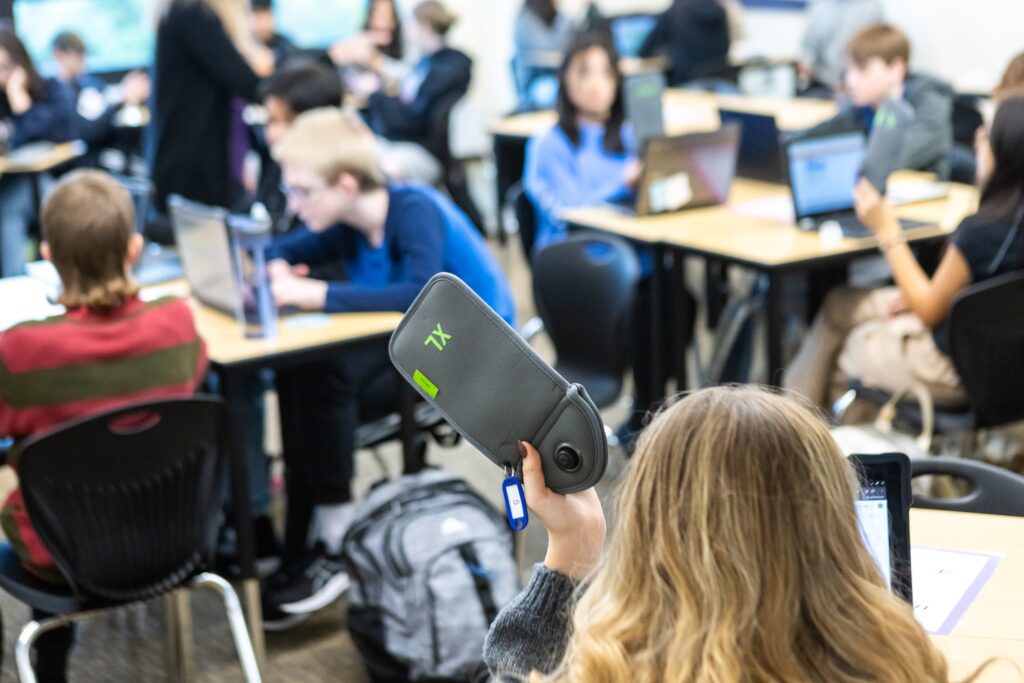Thanks to an executive order signed Wednesday by Governor Tina Kotek, which gives the state’s 197 public school districts until October 31 to develop a policy that forbids smartphone use during the school day, next Halloween may be especially frightening for students throughout Oregon.
For many high school students, who have been used to more relaxed rules, this implies no phone use during lunch or passing periods.
In response to increasing concerns about academic distractions and the negative effects of constant exposure to social media on maturing adolescent brains, Kotek’s decision makes Oregon the 27th state to regulate the use of smartphones during the school day.
Legislation that would have made the state’s position on the use of devices in schools legally binding was supported by a bipartisan group of state politicians. However, their plan was rejected by the Senate Education Committee after clearing the House due to worries that it was overly prescriptive and would be expensive for underfunded school districts to adopt without any additional financing.
Some parliamentarians at the time hinted that Kotek was waiting in the wings, prepared to issue an executive order, which is why the bill’s supporters had not agreed to modifications to allay those worries.
The governor stated on Wednesday that she was driven by the need to defend the rights of all students throughout the state, some of whom attend schools that have been sluggish to address the problem.
According to the executive order issued on Wednesday, the complete prohibition on using devices in class must take effect on January 1, 2026. It leaves it up to individual districts to determine whether to buy lockable pouches for smartphones and smartwatches, mandate that students keep them in their cars, lockers, or homes, or devise an alternative. It does not specify how or where students must store their devices during the school day.
Additionally, it calls on school boards to establish guidelines for disciplining students who disobey the cellphone restrictions, which would be applied consistently. This is a significant shift from the two years ago, when regulations differed from school to school and even classroom to classroom. According to Kotek’s order, suspension and expulsion are no longer options because disciplinary actions cannot involve lost instructional time.
Updated device usage regulations prohibiting cellphone use during the whole day, including lunch, have already been implemented by a few school districts in the state, including Portland and North Clackamas. Students are permitted to carry cell phones in their pockets or in their bags for easy access, and many districts have off-and-away policies that are enforced by specific classroom teachers. Some have attempted to use repurposed shoe caddies to send phones to cellphone jail; however, these kinds of solutions let students to retrieve their phones at the conclusion of class times.
Although many students have expressed agreement that phones distract from education in the classroom, many have vehemently contended that they should be allowed to use their devices for communication with their parents, jobs, and peers during lunch and break times.
Harvey Bloyd, a recent graduate of the Kalmiopsis Community Arts High School in Cave Junction, testified before the Legislature that cellphones are used for a wide range of purposes, such as social interaction, inspiration, interactive entertainment, medical needs, and emergency contacts. I use my device for both medical purposes and to communicate directly with anyone who might need to contact me during the day.
However, students’ opinions on the matter are not all the same. Teens told The Oregonian/OregonLive that they had been initially dubious about the policy, but acknowledged that it had sparked lunchtime conversations and improved focus in class during a visit to Milwaukie High School this fall, where all students have locking pouches that prevent their phones from being used during the school day.
According to Gustavo Barraza, who graduated this year from Milwaukie High, phones have been the cause of several issues at school, ranging from fights in the hallways organized for TikTok to the persistent pings of cyberbullying.
Teachers, on the other hand, have generally favored a universal policy, arguing that it will improve their students’ mental well-being as well as their capacity to run attentive and effective classes.
While testifying before lawmakers, Marianne Schnell-Bruton, a teacher in the Tigard-Tualatin School District, noted, “As educators, we are already being as creative as possible to hold our students’ fleeting attention.” Our attempts to maintain our kids’ entire attention are thwarted when we permit their own devices in the classroom.
kids with special needs who might use their phones for assistive technology, kids who use their phones for medical reasons, and any exemptions authorized by school building administrators are all included by Kotek’s executive order.
The administrators who will implement the bell-to-bell prohibition and the school boards tasked with creating the policies have shown the greatest doubt against a statewide policy.
In a letter to lawmakers, Hillsboro school board member Yessica Hardin-Mercado argued that the state shouldn’t approve a one-size-fits-all solution, saying, “We don’t ban pencils because someone doodles.” When laptops were first introduced, we did not forbid them. We instructed students on how to make sensible use of them. Phones ought to be handled similarly.
Parents who are concerned that they won’t be able to contact their kids in an emergency have also opposed phone bans. However, hundreds of students using their devices during a crisis can disrupt phone lines, transmit false information, and make it more difficult to hide from an invader, according to school officials in Portland, North Clackamas, and other places.
In Oregon, Kotek’s executive action may not be the last word on the matter. The primary sponsor of the cellphone ban measure that the Legislature discussed this session, Rep. Kim Wallan, R-Medford, stated on Wednesday that she intends to reintroduce her bill in a subsequent legislative session in order to give it a chance to become a statewide law.
Julia Silverman writes for The Oregonian/OregonLive about K–12 education. You can email her at jsilverman@oregonian.com.





More Stories
Gov. Tina Kotek issues executive order mandating ‘bell-to-bell’ ban on student cellphones in Oregon schools
Gov. Tina Kotek issues executive order mandating ‘bell-to-bell’ ban on student cellphones in Oregon schools
Gov. Tina Kotek issues executive order mandating ‘bell-to-bell’ ban on student cellphones in Oregon schools